Mastry: Kerry James Marshall
patrick brennan
December 2016
 section from When Frustration Threatens Desire, 1990
section from When Frustration Threatens Desire, 1990
Kerry James Marshall is an accomplished and courageous virtuoso painter who takes on enormous human themes without ever flipping grandiose, trivial or pretentious. He manages to integrate, rather than collage, almost jarringly disparate manners of painting within powerfully coordinated compositions that are astonishing to witness. His images, his depictions of human characters, his storytelling and allusions are no less complex. The breadth of what he includes can feel almost intimidating in that one really has to know an awful lot to follow everything that he’s doing. However, that range isn’t related to demonstrating any hierarchical credibility but to the open possibilities of curiosity and understanding. The paintings are not angled to intimidate. They are, however, insistently present — and confrontational in this presence, in their refusal to go away and in their refusal to pretend not to be here. That they don’t do. I admire that. And there are many layers of presence. There are many ways in.
The internal rhythms of Marshall’s work feel completely original. Nobody puts things together the way he does. There’s a sort of awe at the unprecedented that comes with that too, and there can be plenty of parallels and antecedents that can be called in without contradicting what began this sentence. I’ve thought about the layered coexistence of text, symbol and image that Basquiat practiced, although with very, very different applications and implication. I’ve also thought about how Bob Thompson had likewise appropriated and redirected so much from classical European painting and that both he and Marshall demonstrate a distinctive feel for getting color to speak emotion.
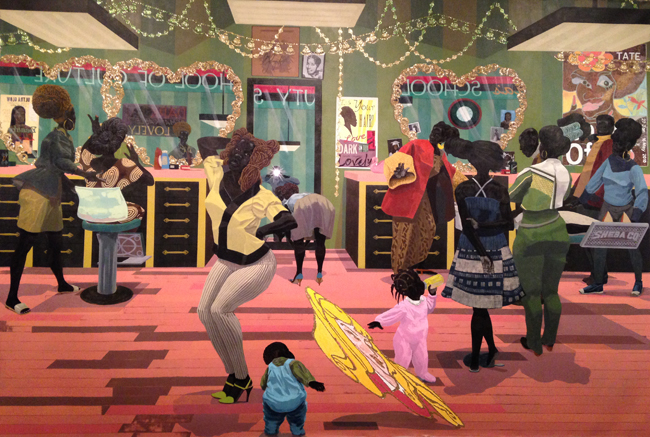 School of Beauty, School of Culture, 2012
School of Beauty, School of Culture, 2012
Some aspects of Marshall’s work make me feel uncomfortable (a discomfort emanating from within my own sensibilities, not as a reflection on his). At different moments, he draws heavily on the designs and mannerisms of classical European history painting as well as upon the Renaissance and Rococo phases of European art. I’m aware that linear perspective represents a tremendous analytical and conceptual achievement, but that whole business of the illusionistic projection of isolated bodies reflecting light in vacuous space leaves me cold, regardless. While I’ve managed to at least recognize and “appreciate” this art in museums (most of the work is spectacularly put together), these phases in European art have always felt remote, stiff and foreign to me as if they were designed for an aristocratic world that would never, ever, include the likes of me.
I feel that same remoteness & discomfort encountering this aspect of Marshall’s work while at the same time remaining curious about what he sees and intends by bringing in those devices. One thought is that he’s appropriating archaic European signals of dignity and veneration to bless his own subjects in a way parallel with the syncretistic incorporation of Christian imagery into Vodou or Santeria. I could also suspect the consternation a different viewer might feel at the presence of “those people” framed inside some of the terms of the prestigious ancestral trophies that are often used to justify Eurocentricism and far worse. But, still, when I imagine transposing such applied anachronism to music, it would seem hard to genuinely feel at home within the sonic boundaries and strategies of Rameau, Couperin or Palestrina, even if they were to be deployed with saxophones, electric guitars or synthesizers and sung in contemporary language about contemporary concerns.
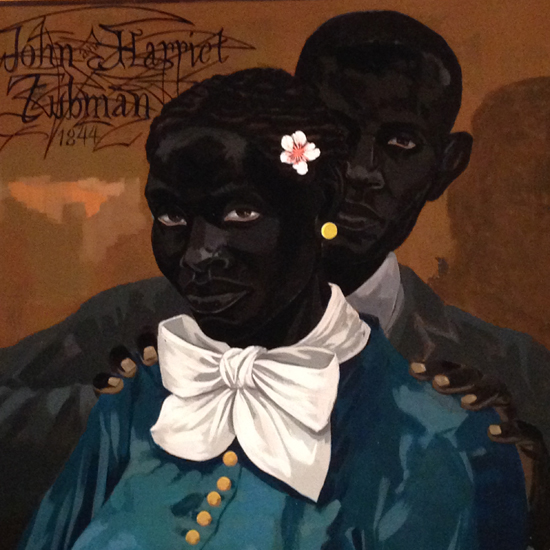 section from Still Life with Wedding Portrait, 2015
section from Still Life with Wedding Portrait, 2015
Marshall’s thematic “black mask” also unsettles me with its memory of the standard issue white supremacist caricature of African faces. Marshall’s painting of melanin rich skin as literally black is a brilliant rhetorical device, always keeping the image a little artificial, maybe even forced in a way that corners the viewer into having to continually contend with this imposition. One of the few places I’ve otherwise noticed ink black depictions of sub-Saharan complexions has been in European medieval portrayals of the African king among the three magi. However, literal blackness seems less a preoccupation among continental Africans (Richard Pryor recounted that when he got to Africa, he didn’t see any n—— there), but then, skin lightening creams have also become enormously popular across the Atlantic, so the USDA stamp, regardless of its self conscious fraudulence, has yet to be expunged and has yet to be contended with.
It seems that Marshall evolved this visual articulation while contending with the notion of invisibility posed by Ralph Ellison in his Invisible Man, that a person is “invisible” only because others refuse to see. So, what, then, does an “unseen” person look like? An absence, a negation of light, a cipher, an allegedly empty tabula rasa, a blank category, a non-entity, a classification implemented through the sort of gag order enforced primarily through plugged ears. The list of people subjected to such regard is long, but Marshall takes special advantage of the homonym of the blacked out blankness of “invisibility” with those perceived as literally “black” in the West (a default convention that, in itself, is not exactly news). He acknowledges the ongoing intrusion of this gag order, but refuses otherwise to give it the time of day.
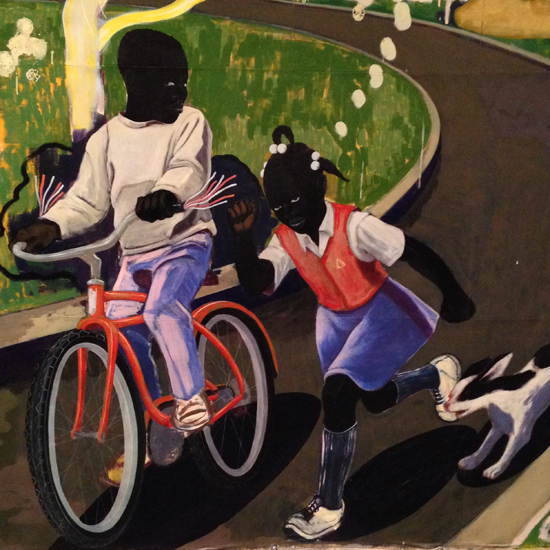 section from Our Town, 1995
section from Our Town, 1995
From the point of view of Marshall’s human subjects, who gaze unapologetically back at their viewers with the same kind of imperturbability that Manet collaborated with in his Olympia, skin is no less a matter of fact than it would be for anyone else. What’s far more important is their own agency, feeling, attitude, awareness and circumstance, the stories that they live. For Marshall, there’s no abiding by the conventions of what Albert Murray called “social science fiction,” that framing of African Americans as victims, as socially inferior objects of pity and charity (and paternalist control, disregard and/or abuse). None of that for Marshall. The personae inhabiting his paintings are fully complex beings, always some mix of vulnerable, innocent, proud, hurt, sad, playful, somehow contending with self regard, courageous, wary, worried, dreaming the sweetness of life, desirous, visionary, relaxed, prancing, defiant, contradictory … (the spectrum of possible adjectives might spin on and on).
For my eye, Marshall transcends the thin crust pasty artificiality that usually haunts the acrylic work of most contemporary painters. The careful modulation of color and the balance worked out between matte and gloss is so warm that there’s no need even to miss their not being in oils.
And his compositions are so cool, so seemingly smooth, that it takes a good while to notice how just many contradictory dissimilars he might be introducing into a painting. The longer one looks, the more amazing it becomes that everything holds together so well.
His bravado and dexterity with color particularly knocks me out as he often juxtaposes extremely subtle areas of tightly related color with moments of brightly contrasting hues that telegraph the buzz of their difference across wide spans of surface like linked quantum particle-waves. His color choices are so exact and so complexly interconnected that the tiniest desafinado would throw the entire painting’s coherence out of whack. His treatment of black and other very dark tones across the skins of the people in his paintings is especially variegated almost to the point of having created a whole new color vocabulary.
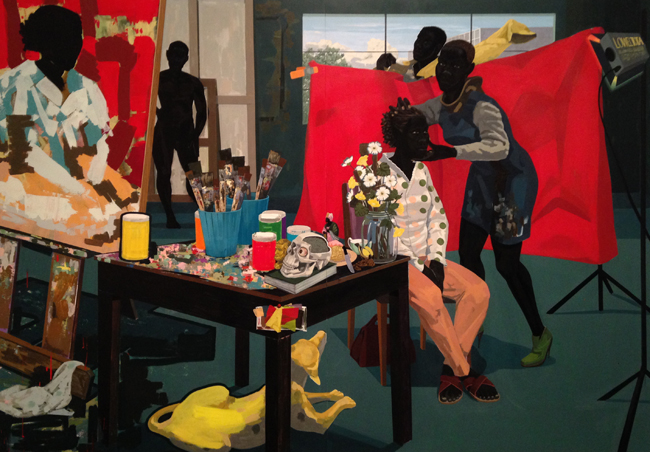 Untitled Studio, 2014
Untitled Studio, 2014
In the career retrospective of his work now at the Met Breuer through January, there is a large portrait of Fred Hampton and his wife sleeping in their room just before his murder by FBI agents, painted entirely in self consciously Ad Reinhardtesque blacks. In the 2014 Untitled (Studio), a light soaked yellow dog sits under a table, next to which an easel supports an unfinished portrait still in a condition of multicolored abstract expressionist strokes. To the right, the model is seated while a studio assistant adjusts her hair. The blue/teal of the floor sings an indescribable luminescence to the red backdrop hung behind the model. On the adjoining walls to either side of this painting hang a recent large rorschach-folded abstract work.
The flair for abstract art (from which he diverged almost 4 decades ago) also reemerges in his beautiful painters series, individual portraits of characters with paint stained palette boards, brushes & clothes — although I’m confused about what he’s saying about each character, whose individual artwork is shown to be color applied to a paint by numbers template. Another room full of portraits stands out that hails notable heroes in the sisyphusian human effort for voice and liberty: Harriet Tubman with her husband, some of the leaders of the Stono Rebellion, the historically ever unportrayed Boston sculptor Scipio Moorhead, Nat Turner with the severed head of the person who’d claimed to own him laying on a bed toward the back.
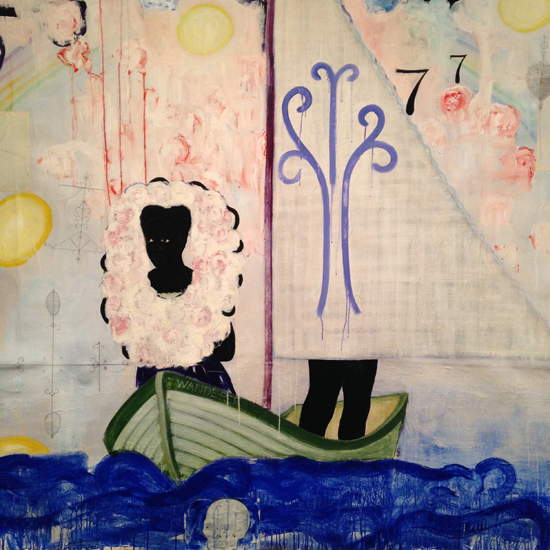 section from Voyager, 1992
section from Voyager, 1992
It’s hard to respond thoroughly to an exhibition of person’s life’s work to date after only two hours of viewing in only 2,554 words, but let me list just a few more impressions. There are elegiac, complicated stories such as a painting recounting the Wanderer, a Long Island luxury yacht retrofitted into a slave ship for the 1858 smuggling of captives (long after such actions had become illegal on the books). In the front of the boat stands a garlanded, goddesslike person as if Yemoja, mother to the orishas and the oceans.
There is the Lost Boys series painted with the intensity of the Greco-Roman-Egyptian funerary portraits. There are the huge tapestry-like annals of both the mythical and the real experience of project housing in Los Angeles, where naturalistic, Marshallesque portrayal coexists with texts, signs & banners, bits of collage, abstract marks and loosely dripping paint.
There are praise paintings such as two celebrating life affirming style, one of men in a barber shop complete with the Euro-medieval benediction of Jesus executed through the hands of the barber and the other of women and kids in the beauty salon, full of daredevil perspective tricks and subtle spacial distortions. To the left of that painting, a woman relaxes on the grass with a spring clamp in the foreground occupying almost more surface than her image does; yet one feels nothing is unusual or out of order. There are Rococo-like portrayals of romance, complete with glitter, song lyrics and musical staves. There’s one very clever, and admiring, nod to Barney Newman. And then, there’s also Self Portrait of the Artist as a Supermodel.
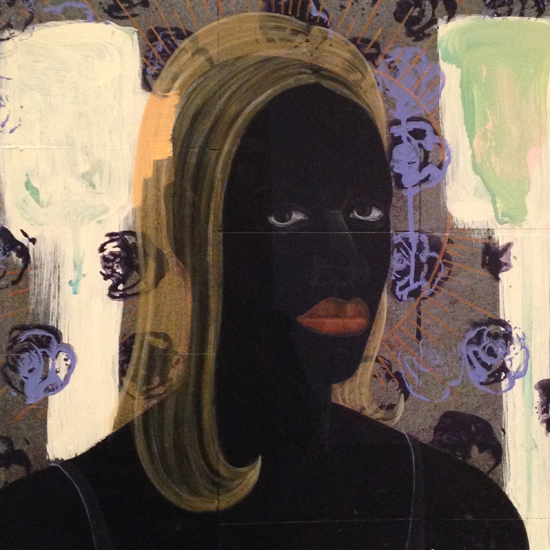 Self-Portrait of the Artist as a Super Model, 1994
Self-Portrait of the Artist as a Super Model, 1994
There are also a few pages from his superhero graphic novel. And, almost as if Marshall’s work didn’t already make the point, we’re treated to a bonus room, Kerry James Marshall Selects, with works from the Met‘s collection including Ingres, Bearden, DeKooning, Lawrence, Hopper, Richter, Dürer and Seurat.
I love the various evidence throughout of Marshall’s true love and respect for so much art from so many different regions and periods and the energy with which he engages with it all. But, I especially appreciate that his engagement is neither hermetically “art about art” nor ironically tongue in cheek about “art.” This is, I believe, because he interacts with artistic process as a laboratory of understanding — for himself no less than for his eventual audiences. I also like that he’s a real painter during a period where seriously painting has gone seriously out of fashion. I value that he doesn’t outsource the work to assistants, and I respect that his personal hand is an active player in the working out of his conceptions.
One of Marshall’s stated goals has been to
make paintings that were so undeniably compelling that . . . there was no way they couldn’t find their place in mainstream museums amongst other works that had the capacity to move people. … I had a project that required a certain understanding of the historical development or the trajectory that art had followed from the Renaissance or before until now. I had to find a way to strategically place myself and the work I did in relationship to that history and to do it in such a way that it had a chance to be included in the general discourse about art-making and painting in particular.
I think that Marshall has succeeded, and powerfully so. His dialogue with the Pan-European canon has so thoroughly absorbed its aspirations that his personal contribution has itself become an indispensable component of that ongoing conversation. In this way, he’s changed history, he’s altered its past (a category that’s always recollected in the actual here and now) to now include what he includes. This feat of aesthetic and political Aikido is no small achievement, and it’s one that the Met exhibition only further validates.
He’d probably agree that this is a pretty complicated scenario to navigate. I tend to hold a lot of reservations about the canon itself, not the work that’s included within it, but the narrative it illustrates. Aside from political, institutional and economic power, just how credible is an art history that proceeds linearly out of Europe into the present (as if it’s the only truly important source in town) to how we invent and reinvent ourselves from here? Is this a trustworthy origin story? In the case of literature, it might be relatively comprehensible that Nigerian writers, for example, have accessed the global conversation through an imperial, cosmopolitan language such as English rather than through Igbo or Yoruba because languages can’t exactly be learned overnight. But in the case of music, the Eurocentric canon has little more than a part of academia left to cling to for absolutist authority, but even from that corner, it can still manage to cast a shadow. When George Lewis asked Roscoe Mitchell about the circulation of the term “Great Black Music” in conjunction with the AACM and the Art Ensemble of Chicago, Mitchell answered, “Well, nobody was calling the music great.”
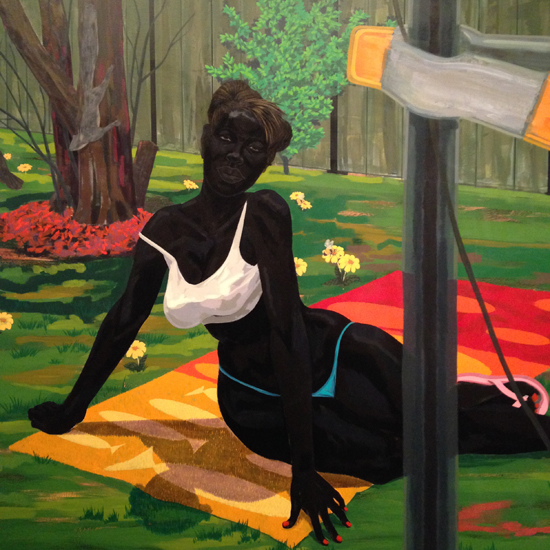 Untitled (Beach Towel), 2014
Untitled (Beach Towel), 2014
The momentum of the status quo, of institutions, comes with a ready made infrastructure and resources capable of delivering rapid potentially large scale impact. As for Marshall’s strategic relation with (and appropriation of) the story line of the dominant canon, one could draw analogies with the gradual amendment of the U.S. constitution, which, in the beginning, restricted the acknowledgement of full personhood to white, male property owners and has since hobbled back and forth toward a practicing maturation of its stated ideals.
One could alternatively challenge or ignore the canon’s legitimacy outright (without having to deny any of the artists it includes) as one could question the worldview and settler colonialist presuppositions that bolster U.S. governance. And there are costs to that too — just ask people from Wounded Knee or Standing Rock. Outside the Eurocentric lineage (actually, having been banned from it), Afrological musicians have annexed and repurposed European musical elements into a whole other musical (and social) worldview that eludes simplistic stories that are organized along linear causation — as canons still tend to be. One could also ask whether Marshall has actually “joined” the canon’s tradition or that he, instead, has, often more affectionately than not, swallowed it up. And does he really, really prioritize European mannerisms over, say, comic book vocabulary?
The wonder around a great artist like Kerry James Marshall is that his positions and work are so rich in complication and ambiguity — not to mention his wicked humor and genuine love for all that he paints — that the work has real staying power; and if human beings survive to see this work a long time from now, they’ll still be looking, again and again. It will always return something new.
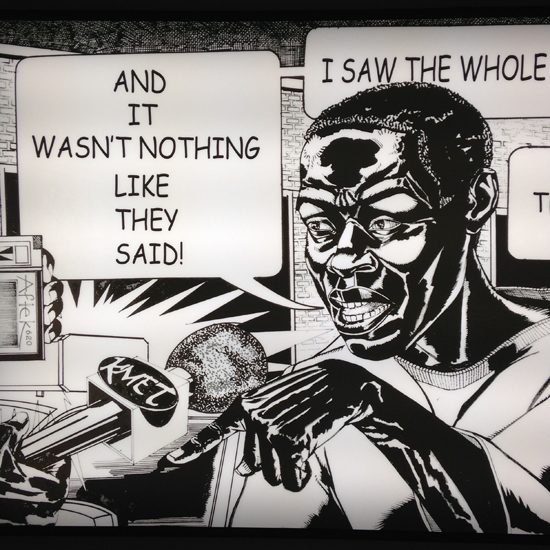 section from Rhythm Mastr, 1999-present
section from Rhythm Mastr, 1999-present
Kerry James Marshall quotes from a 1998 interview with Charles Rowell
Callaloo, Vol. 21 No. 1, p.263-272
http://xroads.virginia.edu/~ug01/westkaemper/callaloo/marshall.html
